 |
SARTHE |
 |
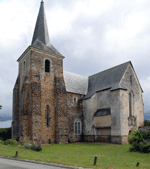 |
Château-l'Hermitage Prieuré de Château-l'Hermitage (Église Abbatiale Notre Dame) |
 |
| Very quiet village. Church is in rue Geoffroy Plantagenet and open. Park outside church but there are only two car spaces available. A visitors' car park is available at the entrance to the village. Ref: 47° 48.2' N/0° 11.0'E |
 |
 |
 |
 |
 |
Marie de Bueil (15th century) Wife of Baudin de Crémon and sister of Jean de Bueil, Admiral of France under Louis XI. Inscription on slab. Below the effigy two angels carry a shield with the arms of Crémon marshalling Bueil; the polychrome here is original. |
| LE MANS |
|
Take The Tram
You can park in one of the many open or underground car parks in the city centre or,
better still, take the tram from the park and ride
facility at the University to the centre. This is a excellent, frequent and
inexpensive service. At the time of writing it was
€1.50 (2018) 'per person, per ride', that is for as near or as far as
you wish to go in one journey. You buy your ticket at a machine at the tram
stop and then 'validate' it at another machine inside the
tram; this is, presumably, to prevent you cheating by using
the ticket for several journeys as there are no 'conductors'
on the tram but presumably 'inspectors' get on at intervals
to check the tickets and fine you.
Tram Stop - Éperon (Line T1) - or - Jacobins Quinconces (Line T2) For the Cité Plantagenet and the monuments listed below
Quirky Tickets
The tram tickets have a plain side and a coloured patterned side with a large arrow to show you which edge to insert into the machine. This sounds easy enough but it does not work: you need to insert the ticket upside down so that the plain side is uppermost and the arrow below where you can't see it. Got it? The car park presents another computer game. To go into the car park you have to press one of two buttons, one for the supermarket and one for the park and ride; you then take a ticket and the barrier opens. Keep it safely! When you return you feed your ticket into a machine in the car park before collecting your car; very sensible is this with no queuing, not enough change problems etc. Feed it in, of course, the way the arrow on the ticket shows you. If it won't go in then turn the ticket over where you'll find another arrow (!) and try again. Pay the modest fee (cash or card) and retain your ticket but remember which arrow was uppermost because when you drive to the barrier on departure you will have to inset the ticket with the other arrow at the top to open the barrier. Don't worry if you've forgotten which way: just turn it over and try again.
A Local Knowledge is a Wonderful Thing!
|
| Cathédral St Julien |
| Free entry. No restrictions for
photography. Cathedral is quite dark inside. As often the case with French cathedral there is no refectory, bookshop etc |
 |
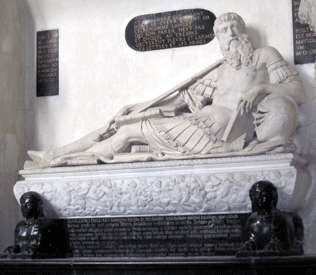 |
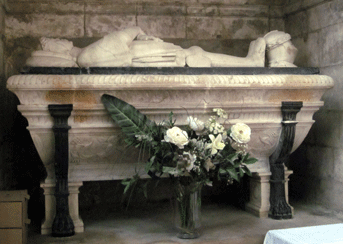 |
 Monuments in the Chapelle des Fonts Left and above (detail): Guillaume de Bellay, French historian. Constructed 1543; attributed to Pierre Bontemps Right upper: Charles IV of Anjou, Count of Maine. Brother of 'Good King René. Marble by Francesco Laurana. Right lower: Cardinal Georges-François-Xavier-Marie Grente (1872-1959) Bishop of Le Mans. Erected in 1965 |
||
 |
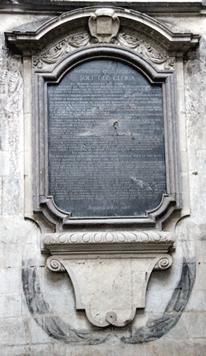 |
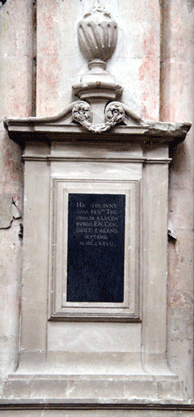 |
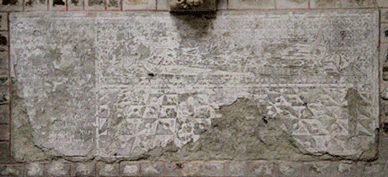 |
||
| Above
Left: Bishop Jean-Baptiste Bouvier (1854) Above Centre: Jean de Beaumant Above Right: Theobald of Luxemburg Lower: Wall mounted incised slab of a table tomb with effigy; the inscription to the left is impossible to read. |
||
|
| Le Carré Plantagenêt |
| 2, rue Claude-Blondeau. Open: Tuesday to
Sunday, 10 am to 6 pm but check website
musees@ville-lemans.fr.
Admission: €5.00 - or buy a pass for the four museums for
€10.00. Very friendly and helpful staff and excellent displays.
Photography is permitted at no extra charge but flash not
allowed. Four of these monuments were originally in the Musée de Tessé but have now been moved to this new site which opened in 2019: the remaining have a different origin which is described with the individual effigy. They are housed in Level 2. Lifts. English leaflets available. Bookshop and toilets. Café just outside in the courtyard. |
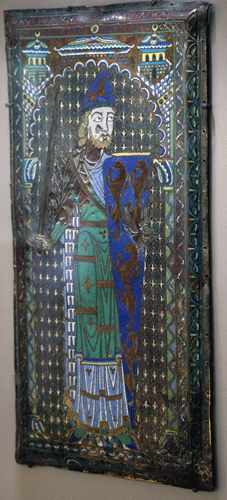 |
 |
Geoffrey Plantagnet, Count of Anjou & Maine (1113 -1151) |
|
Above is the enamel plaque from the tomb of Count Geoffrey: on the left my photograph (taken at an angle because of reflections) and on the left Charles Stothard's coloured etching. It is of Limoges Enamel, which originated near the city of its name around 1100. It was manufactured from a copper plate in which compartments have been cut out and filled with ground glass of various colours. This is then baked to fuse the glass into enamel and finally polished. The inscription, in Latin, when translated, curiously reads: 'By your sword, prince, the crowd of pillagers is put to flight, 'And through your vigilant peace, tranquility is given to our churches.' He is shown wearing ceremonial clothing while at the same time carries a shield and brandishes a drawn sword. Although his head gear is sometimes called a Phrygian cap, it is more likely a helmet The plaque was almost certainly part of Count Geoffrey's monument in Le Mans cathedral, probably wall mounted about his grave, which no longer exists. The heraldry on his shield is the only example of his arms: his only existing seal does not show them although other contemporary seals do. This is not the first representation of arms but it is the first coloured example; later they appeared in stained glass and illuminated manuscripts. The lions were brown edged with gold and the field blue. How many lions are displayed? There have been several guesses from the eminent art historians but I think I am entitled to guess as well as they! It looks like half of the shield is hidden from our view which would make four on the top row; the visible second row lion stands between the upper pair so if we continue this pattern there will be three on the second row and then two on the bottom row, making nine. Of course the real answer should be five: four of the shield and one on his hat! The plaque has had a somewhat uncertain career as it disappeared several times and reappeared again. It finally settles in the Musée de Tessé and this is where Charles Stothard executed his preliminary drawing. It was transferred to the present site when the new museum open. An article discussing this monument may be found here. |
|
|
Something about Count Geoffrey or A Surfeit of Matildas |
|
Geoffrey the Fair was born in 1113 the son of Fulk V, Count of Anjou (called Fulk the Younger) and Ermengarde, Countess of Maine. He was to inherited both counties from his parents but this was only the start of the rise of the dynasty which was to rule land from the Scottish borders to the Pyrenees. He was the first of his family to be known by the surname Plantagenet, it is said because of his habit, for no good reason that I can ascertain, of wearing a spring of yellow genêt (Plana genista or broom) in his cap. Fulk finally achieved his ambition to form a political alliance with Normandy by marrying Geoffrey to Matilda daughter of King Henry I of England and his wife Matilda; Henry was also now Duke of Normandy. Matilda was eleven years older the Geoffrey and was the widow of the German Emperor Henry V. She was said to have been a proud and haughty women who felt it something of a comedown marrying the son of a count having once been an Empress. Fulk left Europe to marry, as his second wife, Melisende, daughter of King Baldwin II of Jerusalem and following Baldwin's death he became King of Jerusalem by right of his wife. Stephen of Blois, who was married to Matilda of Boulogne and who was to help him in the struggle to come, was like Henry's daughter Matilda a grandchild of William the Conqueror and his wife Matilda of Flanders. King Henry's only legitimate son had died in a ship wreck and he had named Matilda his heir and required the barons to swear fealty to her. When Henry died, Stephen saw his chance and seized both England and Normandy. Perhaps the barons despite their oath were not so keen as having a woman as their overlord especially one with Matilda's reputation. Anyway Stephen was a nice guy and probably a flexible one: far better to break their oaths than have a female version of old King Henry rule over them. Stephen's reign began well but soon deteriorated. Matilda was incensed at this betrayal and she and Geoffrey attacked and took Normandy as Stephen began to loose his grip on the situation. The attempt on England was not so successful, even though she was aided by her loyal half brother Robert of Gloucester, and led to a stalemate situation and ten years of bitter civil war. Geoffrey died suddenly in 1151 at the early age of 38 but Matilda continued her attempt to take England, eventually joined by her teenage son Henry. In due course the parties were weary of a war which no side could win and Stephen and Henry began to negotiate a settlement. Stephen's son and heir Eustace suddenly died and an arrangement was eventually reached in 1153 that Stephen was to keep the throne until he died but Henry was then to succeed him. This was soon as Stephen died the following year and Henry became king as Henry II. Henry had married Eleanor of Aquitaine, curiously like his father marrying an older woman, so acquiring the County of Poitou and the Duchy of Aquitaine. He now ruled a large area of Western Europe as has been referred to in the first paragraph. |
|
| Medieval Effigies |
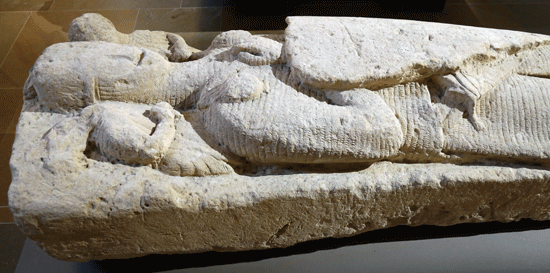 |
 |
 |
|
 |
The first four of the effigies represent
members of the Beaumont
family from Maine. They
were discovered at the site of the
Abbey of Étival-en-Charnie, Chemiré-en-Charnie, Sarthe, in
1846. The first (above and left) is said on the museum notice to be Raoul V, Vicomte de Beaumont (1093-1133) founder of the Abbey in 1109, where his sister Godechilde became the first abbess. In the Wiki entry it states that the Abbey was founded by Raoul VII; however this is the same person owing to confusing variation in the numbering. The first of the Gaignieres drawings below states that it is of Raoul the founder but without a number. This is clearly a drawing of the effigy shown here and which also shows the arms on the shield, presumably painted: or, three chevronels gules. Limestone. First half of XIIIth century. |
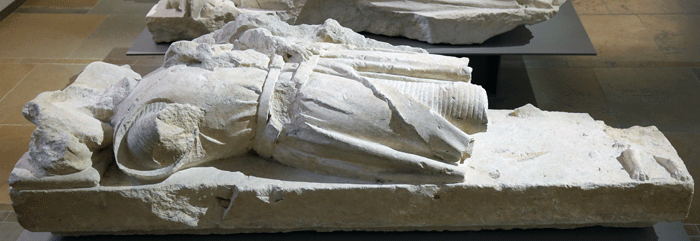 |
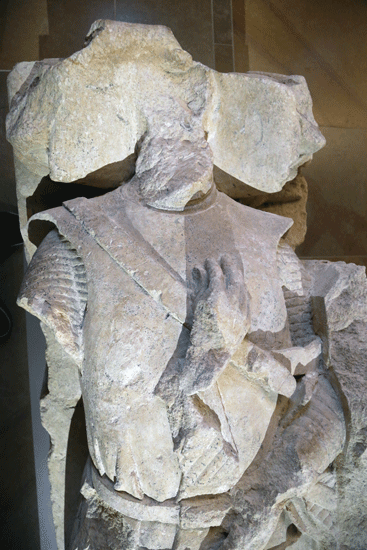 |
 |
 |
The second effigy represents Raoul VI, Vicomte de
Beaumont (1093-1133). This Raoul, who was the grandson
of the above, accompanied the Dauphin (son of Philip
Augustus and later King Louis the Lion) to England to join the
rebel English barons in their struggle against King John. He
later to take part in the Fifth Crusade where he was captured. He
founded the Charterhouse of Parc at Saint-Denis d'Orgnes. He is also called Raoul VII or VIII Note that the carving is more in the round and the armour of a slightly later period. The second of the Gaignieres drawings clearly is of this badly damaged effigy. Again we see the shield with the same arms as above. Limestone. Later XIIIth century. |
  |
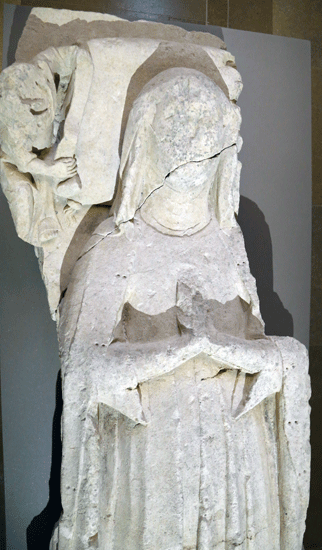 |
 |
This is third effigy and the first and
only lady in the series. It represents
Agnès,
Viscomptess de Beaumont (c 1250-1360)
She was the daughter of Raoul VII and
Agnès de la Flèche. In 1253 she married Louis de Brienne, son of
Jean de Brienne, King of Jerusalem. Also featured in the Gaignieres series. Limestone. Early XIV Century |
 |
 The fourth effigy and third knight is Jean I de Brienne, son of Agnès, above. This is the best preserved of the four. His shield has arrns carved in good relief; Gaignieres drawing shows the tinctures: Azure fleur semé de lys or, a lion rempant or Limestone. Early XIV Century |
 |
|
 |
 |
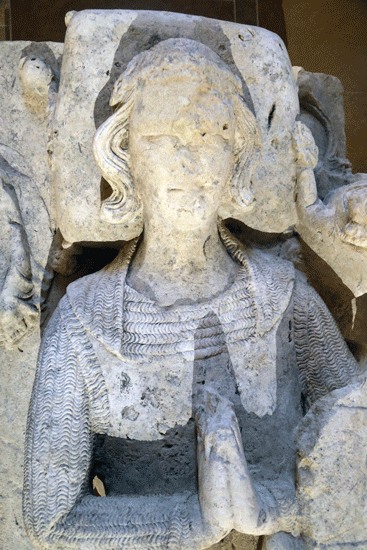 |
 |
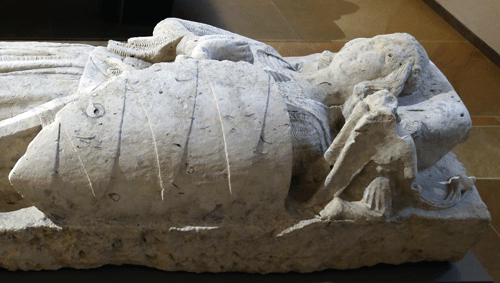 |
Jean de Maule (1323)
Originally sited in a chapel of the Church of Doucelles (Sarthe,)
the effigy was brought in 1854 to the First Archaeological
Museum in Le Mans by its then curator and master glass maker, Eugène
Hucher. The shield displays his arms Limestone Second half of XIV Century |
 |
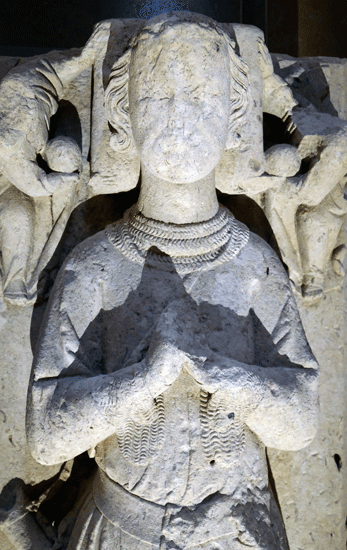 |
 |
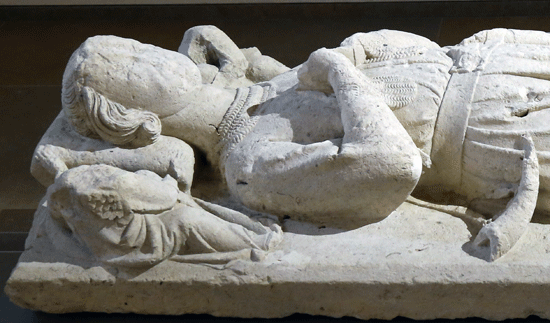 |
Unknown: called The Knight of the Horn. Brought from the Abbey of Perray-Neuf at Prégigué in 1894 to the First Archaeological Museum of Le Mans. There is no shield to display arms or any other method of identification. A hunting horn hangs from his belt on the right hand side, hence his name. Limestone. First half of XIV Century |
 |
 |
 |
 |
 |
 |
| Raoul V | Raoul VI | Richard (son of Raoul VI) not shown |
Agnes | Louis de Brienne not shown |
Jean de Brienne |
 |
 |
 |
 |
| Tombstones from Collegiate Church of
Saint-Pierre-le-Cour, Le Mans Left: Jeham Martel (early 16th C). Above: 1. Huet le Bœuf (early 16th C) 2. Étienne Dreux (c. 1447), 3. Jehan Goyet (C. 1467) |
|||
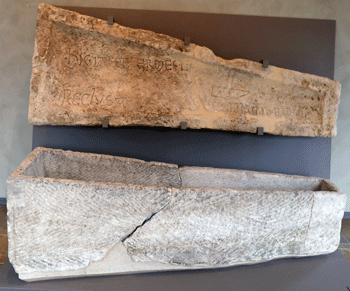 |
 |
| Merovingian Sarcophagus (Late XI the Century - A
Curiosity There are several sarcophagi in the museum but this shows carving on the inside of the lid. It reads (in Latin): 'Here lieth Ermech Recluse (feminine form) and on the other side Ma(thieu) Leperier and a masons' hammer. |
| Why two names and why inside the lid? The museum states that the sarcophagus had been reused on two occasions: at the end of the 11th century for Ermech and then in the 15th century for Mathieu Leperier, a stone cutter indicated by the carved masons' hammer. I suppose it is possible that the sarcopagus was made for Ermech by the stone mason Mathieu, and it his his signature we see here. |
 |
Malicorne-sur-Sarthe Église Saint-Sylvestre |
 |
| Large village, centre of a local porcelain industry. Park free by the river: the church is a short walk away. Church is open but the door inside the porch is locked; however a small door to the right is open and this leads via a short corridor to the nave. An excellent booklet about the restoration of this tomb may be obtained free at the tourist office at the opposite end of the village. Ref: 47° 49.0' N/0° 05.2' W |

The monument is housed in a small chapel entered by two
arched doorways which are closed by grills; one of these may
be see in the photograph on the bottom right on the far left
hand side. The monument is thus difficult to photograph as
well as I should like.
|
 |
 |
|
A Tale of Discovery and
Restoration (based on Tombeau du sire de Chaources) |
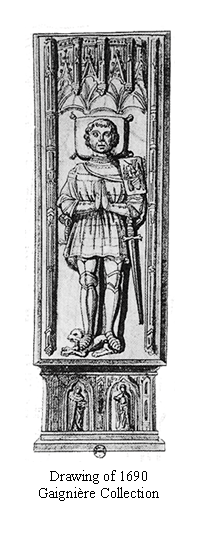 The monument dates from the second half of the XV century and represents a member of the Chaource family, lords of Malicorne, although it is not known precisely who this might be, there being no inscription extant or recorded. It is now situated in the centre of the 'de Chaource' chapel, dedicated to St Anne; the name change dates from 1843 when the monument was first sited there, although not in the present position, after being moved around the church as well as being damaged and repaired on several occasions . The tomb chest has a series of arches containing weepers on three sides, although on one side these arches are empty. The effigy is of a figure wearing armour of the period, wearing a sword, and with a gablet above his head. This history of its movements can be traced, at least in outline, from the archives but the state of the monument at different periods is more uncertain. A drawing in the collection of Gaignières of 1690 shows it was first located on the left of the choir. Half a century later, owing to its poor condition, it was removed to the vault of the lords of Malicorne, located in the chapel of Beaumanor which adjoins the south flank of the choir. Rediscovered in 1828, it was brought back into the church and placed in the nave in front of the altar of St James. Fifteen years later, following complaints from the parishioners that it took up too much space, it was decided to embed it under an arch in the west wall of St Anne's Chapel. A later photographs shows that only one face of the tomb chest remains visible - the left long side. There were six arcades on this face containing weepers. A large arch at this time was also cut to join the chapel with the nave. A restoration project was launched in 1989 by the Historic Monuments Service. In 1992 several stone fragments were discovered built into two altars and indentified as having belong to the tomb. The head and foot faces of the tomb chest were discovered containing very mutilated weepers, one face being broken in two pieces. Half of the original slab which originally supported the effigy was also discoed although this had been sawn in two at some point. In spite of the lack of the right hand longitudinal face of the tomb chest these discoveries confirm what the survey prepared for Gaignières suggests: that the monument was meant to be free standing and not against a wall. It was decided to site the tomb in the centre of the chapel with the head facing the east. If we compare the effigy before its restoration with the drawing of 1690, we see that he has lost his dagger from his right hand side, the lion below the feet and the shield which was carried on the left shoulder; this latter held an heraldic device. Also lost are the mouldings on either side of the effigy and the tassels on the cushions. Several elements, such as the nose and sword blade, were found to have been rebuilt with plaster and whitewashed. The restorers did not recreate the missing parts, such as the dagger and shield, being anxious to preserve the authenticity. The effigy was just cleaned and the XIX century plaster restorations cleaned and coloured to match the white limestone of the effigy. The slab had been reconstructed in the XIX of reinforced concrete; this was now replaced by tuffeau and the fragment which had been discovered, as mentioned above, was incorporated into it. The side panels of the tomb chest were set into position; the one in two pieces at the foot and the other at the head of the monuments. The weepers, which were in poor condition, were sympathetically restored in this instance. The right hand longitudinal panel had never been discovered nor is there any representation of it. However its existence was certain. The chief architect of this project decided to take a silicone rubber impression of the extant panel so that an exact copy could be made. However no weepers were added to this side - the least visible - so the niches remained empty. |
| The List states there is a gisant in Château de Lute in the commune of Le Lude, although there is no information of its type.. However, I have contacted the owners who tell me there is only an angel sculpture in the château and that this a copy of a medieval sculpture by the French artist Jean Barbet; and that the original has been in the Frick collection in New York since the beginning of the 20th century. Until further information is received we must assume that the List is incorrect in this instance. |
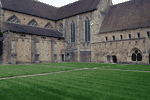 The church from the former cloister |
Yvré-l'Évéque: L'Epau Abbey |
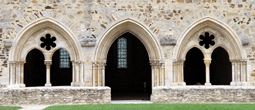 The chapter house. The effigy of Berengaria may just be made out: right of the doorway, first window opening, the tiny gray structure. |
|
East of Le Mans, this was the
foundation and burial place of Berengaria, Queen of
Richard the Lionheart. Her effigy has now been returned
to the chapter house and is placed over the vault where her body had
remained since its burial. Please note that the effigy
is not, as still given in some guide books, in Le Mans
Cathedral where it was situated for safe keeping for
many years. . The Abbey has now been restored and acts as a cultural centre - rather like Fontevraud but much smaller. There is a modest entry fee and car parking at the Abbey is free. NB: The Abbey closes for lunch. |
| How To Find It from the Channel Ports |
| You'll see a large sign with a photograph of Berengaria's effigy well before Le Mans but it's a way to go yet! Do not enter Le Mans but by pass the city north on the A11-E50; leave this road east of Le Mans on the A28, travelling south.. Leave the A28 on the N23 - the first (and only?) exit and pass through the toll gate. Ahead is a roundabout but L'Epau is not marked on the entry sign post. Take the last exit - N23R - to Changé (L'Epau is now marked telling you to "follow Le Mans"); leave Changé on the D152 to Le Mans; L'Epau is the on the right. Good luck! Do not put Changé into SatNav as there are more than one! |
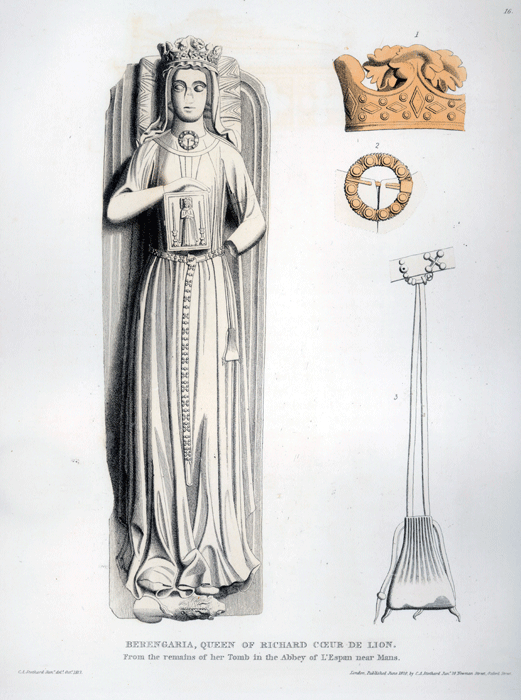 |
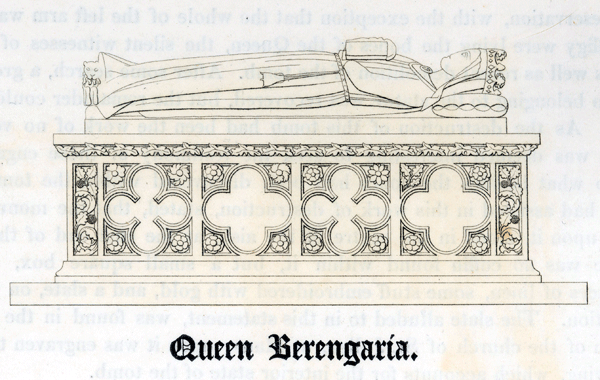 |
| Charles Stothard's etching of the effigy and
details (left) and drawing of the effigy and tomb chest
(above) Note: this tomb chest is not the original but a later replacement and the bones found inside by Stothard are not those of Berengaria, whose skeleton remained in the vault where she was originally buried and over which the effigy, on a modern base, has now been replaced. The full story may be found here. |
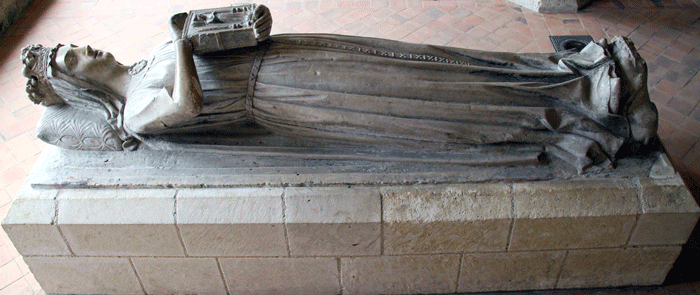 |
 |
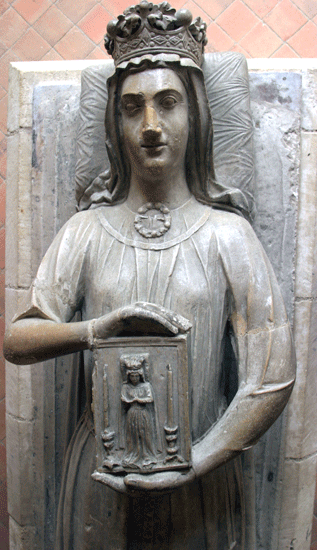 Berengaria of Navarre ( 1165 - 1230) Her effigy now on a modern plinth with the plate from Le Mans Cathedral attached. |
 |
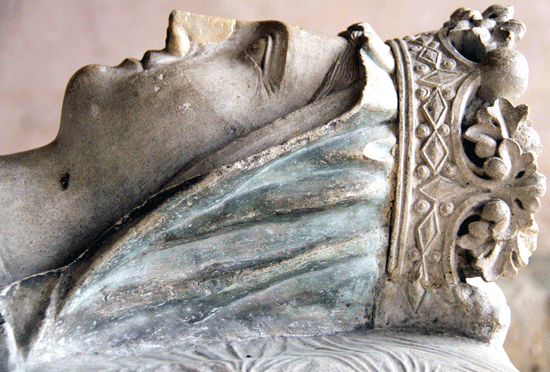 |
 |
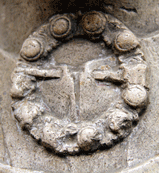 |
 |
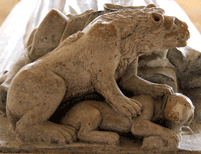 |
 |
| Far Left: Detail
of the book Berengaria is holding; Above Left: jewelled
clasp of the Queen's gown; Above Centre: Her purse - note
the coins carved at its bottom; Above right: Animals at
her feet Far Right: Fragments of the original tomb chest. |
||||

